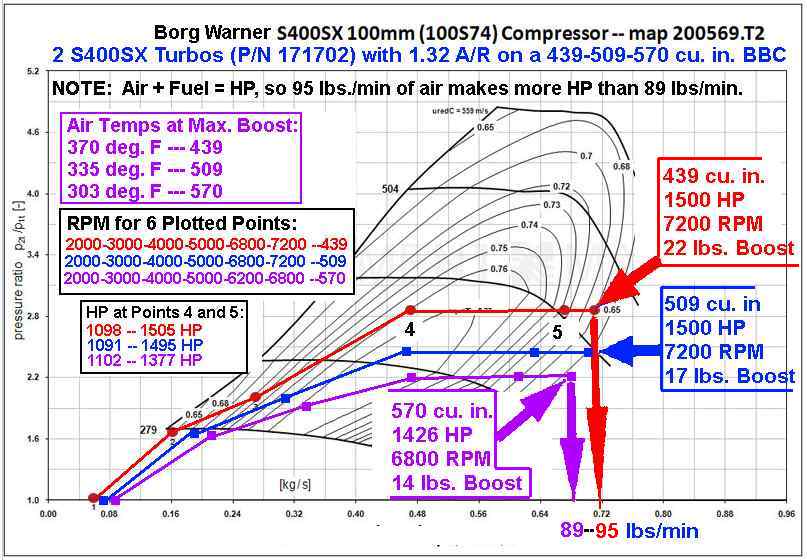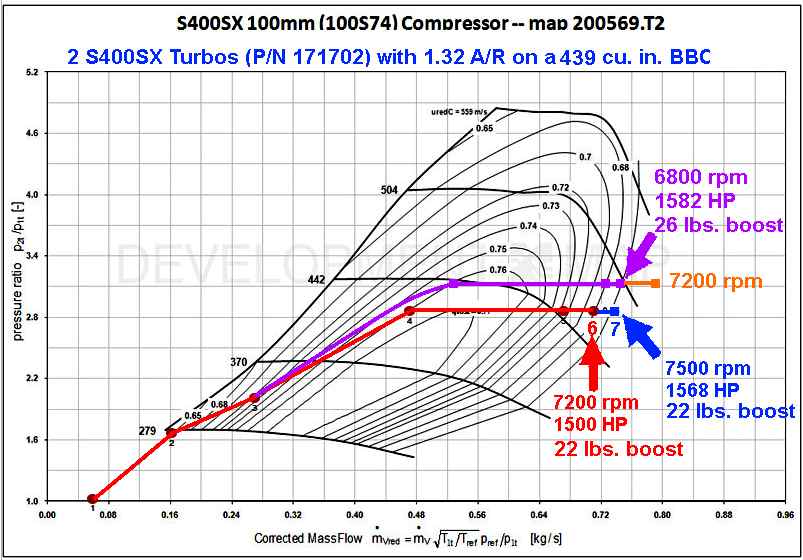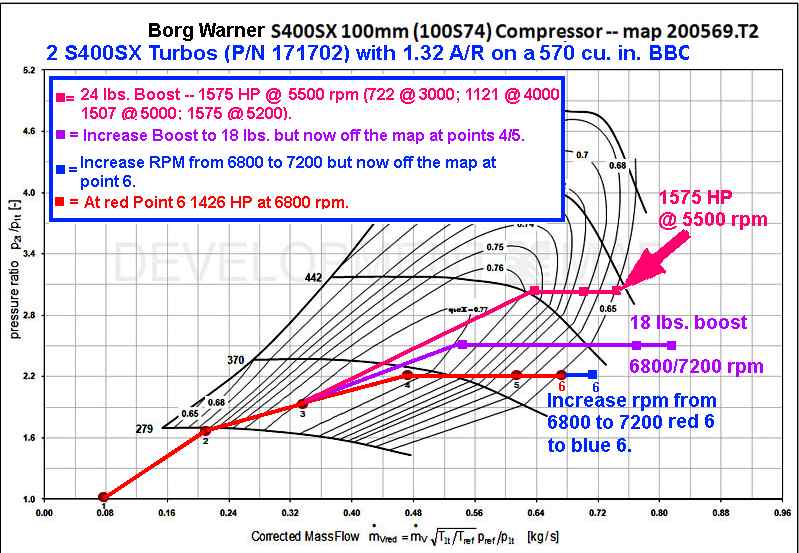
...........Return To Mine & Other Bonneville Car Construction Pages
=============================================================
--- Borg Warner S400SX (P/N 171702) on 439-509-570 BBC ---
=============================================================
On this page we will look at Borg Warner's S400SX (P/N 171702) turbo that can be bought for less than $800 and is in their AirWerks line of newer dual scroll extended tip design turbos. This is a pretty versatile turbo that will work with a number of engines. Here we are looking at using it for Bonneville and comparing using two of them on three different BBC engine sizes, a 439, a 509 and a 570 cu. in..
As you will see you could build a B motor (up to 440) and A motor (up to 500) and a AA (over 500 cu. in.) with the same BBC block and bore size just going with different cranks if you stayed away from the 570 cu. in. and use a pair of these S400SX's with all of them.
Those three engine sizes would be a good idea if you wanted to use these turbos as we will see that this turbo is really too small to take full advantage of a 570 but it will work to a degree. Proper turbos for a 570 are going to cost over $2000 each but you would then be in the 2000+ HP range if that is what you needed. If 1400 to 1500 HP will work for you and you have a large motor like the 570 then these cheaper turbos could be the ticket.
Before you go on take a minute and look at the following compressor map for the S400SX and notice that it has plots on it for the 439, 509 and the 570 with references to all three. If you built say a 495 for an A motor just look at the 509 data as it will be plenty close.

Above we can see that the 439 and the 509 can make 1500 HP with a pair of these turbos and as we will see later we can even make some more HP with the 439 and stay on the map. The 570 can make a little over 1400 HP with 2 of these turbos, but at that point they just can't keep up with the air demands of the 570.
Air and fuel make HP and the turbo makes air. We can see that at the vertical red arrow the 439 and 509 are using 95 lbs/min of air, which the turbo's compressor is making. The turbo is making 89 lbs/min for the 570. If we ask it to make more it gets off the map into the inefficiency choke zone to the right and is even going there at the 89 lbs./min.
As was mentioned above air mixed with fuel makes our HP. If we assume that the heads and cam are maximized already there are three things effecting how much air the engine needs to make a specific HP.
1. The displacement of the engine in cu. in. or liters. The larger the motor the more air it consumes during two revolutions of the motor.
2. The rpm the engine is operating at. The higher the rpm the more times it has to fill the cylinders per minute so the more lbs/min of air it needs.
3. The pressure the engine is operating at. At sea level the atmospheric pressure is forcing air into the cylinders at about 15 psi.. If we put a blower on the motor and run say 15 lbs. of boost we have added 15 lbs. of pressure to the 15 lbs. of pressure the atmosphere is producing which results in twice the lbs./min of air available to the engine so twice the HP. In reality it is a little less.
So boost increases the air to the engine but you can't base HP just on the boost. Above we see that the 439 is making 1500 HP at 22 lbs. of boost and the 509 is making the same 1500 lbs. at 17 lbs. of boost. They are both consuming the same amount of air, thus the same HP. The rpm is the same but the displacement is different so to get the air we need in the 409 to make the same HP we need to run a higher boost on the 409. This is a very important point that what we are after is air to make HP not necessarily a certain boost figure. You go to the boost level needed to deliver the desired air. Think in terms of how much air you need to make a certain HP not how much boost.
The compressor map above is divided into what are called efficiency islands and the compressor is most efficient if your plotted points for boost and air needed are in the center of the map. Notice that the compressor is operating at a higher efficiency on the 409 where as the 509 and the 570 are right at the edge of the map.

There is still a little more in the way of HP to be had with the 439 engine. If we stay at the 22 lbs. of boost level and can move the rpm's up to 7500 from 7200 there is an additional 68 HP to be gained. More rpm's at the same boost level demands more lbs/min of air and in this case the turbo's compressor can make it and still stay barely in the map at the right edge.
Our other option is to run a higher boost and get up where the map lays over a little further to the right and the compressor is capable of producing more lbs/min of air. So we can up the boost to 26 lbs. but have to reduce the rpm back down to 6800 to stay on the map. If we can deal with the 6800 rpm gearing wise we have another 82 HP by taking this track. If we would take the rpm higher at this higher boost level we would start to go off the map as shown by the orange line where the point at the end of it is at 7200 rpm.

Back to the 570 motor to look at options to increase the HP. If we try and increase the rpm from 6800 to 7200 (blue line above) we end up going off the map to the right. So that isn't a good solution. Already we are running a max rpm of 6800 with the 570 vs. 7200 with the 439 and 509. Hopefully we can take care of the decreased rpm via taller gearing in the car if this is a land speed car.
If we try and increase the boost to say 18 lbs., middle line, vs. the 14 lbs we are running at the red line we also go off the map way before we even get to 6800 rpm so another option that doesn't look good.
The only option we have to move further to the right on the map where the compressor is making more lbs/min of air is to increase the boost by also severely lower our upper rpm rev line to avoid going off the map. This would only work if you have the gearing available to make it work but it can really raise the HP. From 1425 on the bottom line to 1575 HP on the top line where we are running 24 lbs. of boost but limiting the rpm to 5500.
The other negative to lowering the red line is can you keep the motor in the HP/torque curve on shifts as you will drop down quite a ways on each shift depending on your transmission gear ratios. At 3000 we are making 700+ HP and by 4000 1100+ HP.
In conclusion we can see that we can effect where we are on the map based on, one the displacement of the motor; two, boost pressure the motor is operating at and finally the third being the rpm the motor is operating at. The only way to really have a good idea if a turbo is going to work is to use one of the turbo calculators, such as Borg Warner's MatchBot, and input the data for the engine and the conditions it is going to be operating at. I used 5500 feet in elevation and 90 degrees to figure all of the above trying to duplicate Bonneville,
Sumner
====================================================
...........Return To Mine & Other Bonneville Car Construction Pages